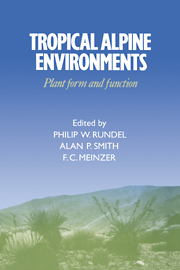Book contents
- Frontmatter
- Contents
- List of contributors
- Preface
- 1 Introduction to tropical alpine vegetation
- 2 Tropical alpine climates
- 3 Páramo microclimate and leaf thermal balance of Andean giant rosette plants
- 4 Comparative water relations of tropical alpine plants
- 5 Cold tolerance in tropical alpine plants
- 6 Anatomy of tropical alpine plants
- 7 Environmental biology of a tropical treeline species, Polylepis sericea
- 8 Morphological and physiological radiation in páramo Draba
- 9 Sediment-based carbon nutrition in tropical alpine Isoetes
- 10 Functional significance of inflorescence pubescence in tropical alpine species of Puya
- 11 Turnover and conservation of nutrients in the pachycaul Senecio keniodendron
- 12 Soil nutrient dynamics in East African alpine ecosystems
- 13 An overview of the reproductive biology of Espeletia (Asteraceae) in the Venezuelan Andes
- 14 Population biology of Mount Kenya lobelias
- 15 Population biology of Senecio keniodendron (Asteraceae), an Afroalpine giant rosette plant
- 16 Population dynamics and flowering in a Hawaiian alpine rosette plant, Argyroxiphium sandwicense
- 17 Plant form and function in alpine New Guinea
- 18 Alpine herbivory on Mount Kenya
- 19 Biotic interactions in Hawaiian high elevation ecosystems
- 20 Tropical alpine ecology: progress and priorities
- Index
7 - Environmental biology of a tropical treeline species, Polylepis sericea
Published online by Cambridge University Press: 21 October 2009
- Frontmatter
- Contents
- List of contributors
- Preface
- 1 Introduction to tropical alpine vegetation
- 2 Tropical alpine climates
- 3 Páramo microclimate and leaf thermal balance of Andean giant rosette plants
- 4 Comparative water relations of tropical alpine plants
- 5 Cold tolerance in tropical alpine plants
- 6 Anatomy of tropical alpine plants
- 7 Environmental biology of a tropical treeline species, Polylepis sericea
- 8 Morphological and physiological radiation in páramo Draba
- 9 Sediment-based carbon nutrition in tropical alpine Isoetes
- 10 Functional significance of inflorescence pubescence in tropical alpine species of Puya
- 11 Turnover and conservation of nutrients in the pachycaul Senecio keniodendron
- 12 Soil nutrient dynamics in East African alpine ecosystems
- 13 An overview of the reproductive biology of Espeletia (Asteraceae) in the Venezuelan Andes
- 14 Population biology of Mount Kenya lobelias
- 15 Population biology of Senecio keniodendron (Asteraceae), an Afroalpine giant rosette plant
- 16 Population dynamics and flowering in a Hawaiian alpine rosette plant, Argyroxiphium sandwicense
- 17 Plant form and function in alpine New Guinea
- 18 Alpine herbivory on Mount Kenya
- 19 Biotic interactions in Hawaiian high elevation ecosystems
- 20 Tropical alpine ecology: progress and priorities
- Index
Summary
Introduction
It is likely that Polylepis (Rosaceae) occurs naturally at higher elevations than any other arborescent angiosperm genus in the world. The 15 species (Simpson 1979) are confined to the South American Andes where they occur primarily in tropical alpine environments. Some Polylepis species tend to form discrete forest stands reaching elevations over 5000 m, well above the upper continuous forest limit (timberline). Throughout their high altitude distribution most members of this genus are exposed to rigorous climatic conditions in which diurnal temperature variations by far exceed seasonal ones and night frosts are frequent.
The genus is exclusively arborescent (trees or shrubs), with individuals ranging in height from 1 m to no more than 30 m. The trees tend to have twisted, crooked stems and branches, particularly in open, exposed habitats. The form and branching pattern of some individuals resembles those of krummholz trees found in temperate alpine regions. The bark is deep red in color and consists of several layers of thin, exfoliating sheets. Although the exfoliating bark is particularly thick at the base of the stem or large branches, the insulating effect is by no means comparable to that of the marcescent leaves that surround the stem of the adjacent giant rosette plants (Smith 1979; Goldstein & Meinzer 1983). The leaves are compound and alternate but often appear whorled owing to the compression of internodes at the branch tips. The leaflets are small, dark green above and are covered with dense, silvery trichomes on the underside in several species.
- Type
- Chapter
- Information
- Tropical Alpine EnvironmentsPlant Form and Function, pp. 129 - 150Publisher: Cambridge University PressPrint publication year: 1994
- 27
- Cited by



